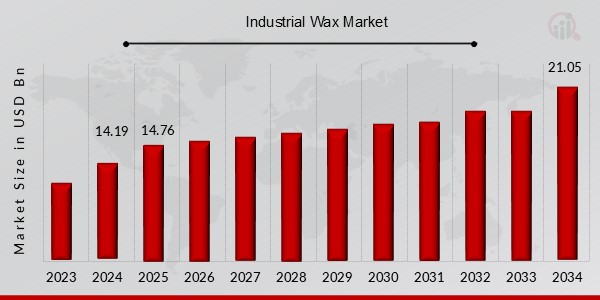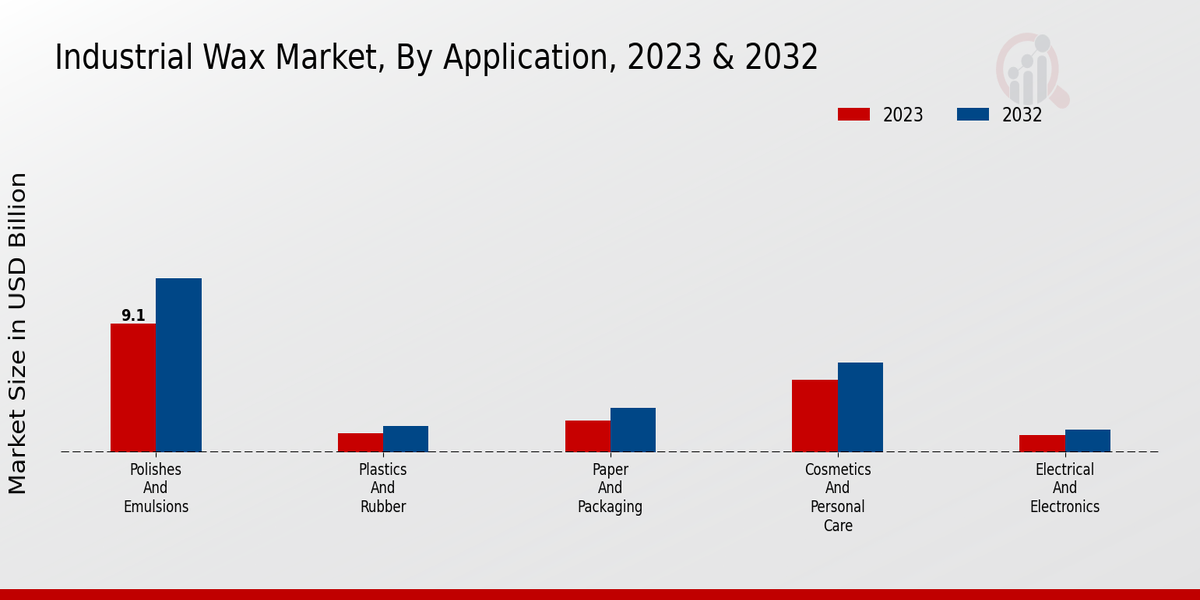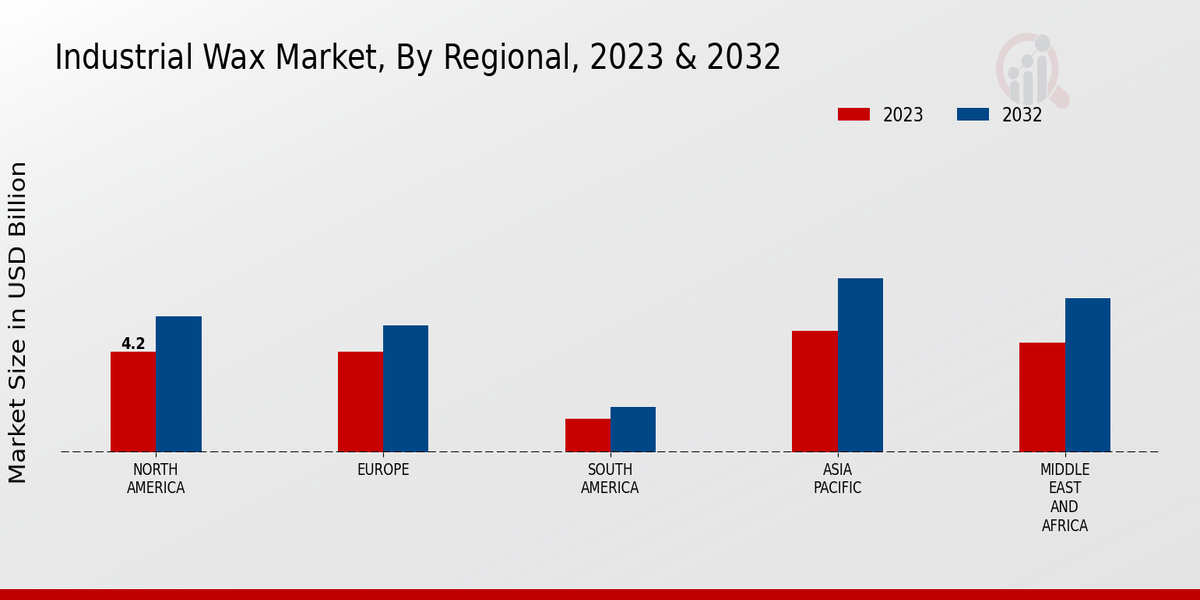Global Industrial Wax Market Overview
The Industrial Wax Market Size was estimated at 14.19 (USD Billion) in 2024. The Industrial Wax Industry is expected to grow from 14.76 (USD Billion) in 2025 to 21.05 (USD Billion) by 2034. The Industrial Wax Market CAGR (growth rate) is expected to be around 4.0% during the forecast period (2025 - 2034).
Key Industrial Wax Market Trends Highlighted
Industrial wax is finding increased demand in adhesives, printing inks, and paper coatings applications owing to its excellent bonding properties, printability, and water resistance. Additionally, rising industrialization and urbanization in emerging economies are driving the growth of the industrial wax market.Key market drivers include the growing demand for wax in the packaging, pharmaceutical, and cosmetic industries. The use of industrial waxes as an ingredient in lubricants, polishes, and metalworking fluids is also contributing to market growth.Recent trends in the industrial wax market include the development of sustainable and environmentally friendly waxes, as well as the increasing use of waxes in new applications, such as bio-based coatings and 3D printing. Opportunities for exploration lie in the development of specialized waxes with tailored properties for specific end-use industries.
 Source: Primary Research, Secondary Research, MRFR Database and Analyst Review
Industrial Wax Market Drivers
Rising Demand for Industrial Wax in Packaging
Source: Primary Research, Secondary Research, MRFR Database and Analyst Review
Industrial Wax Market Drivers
Rising Demand for Industrial Wax in Packaging
Industrial wax plays a crucial role in the packaging industry, ensuring the protection and preservation of various products during storage and transportation. Its ability to provide moisture resistance, barrier properties, and flexibility makes it an ideal choice for packaging applications. The growing demand for packaged goods, particularly in the food and beverage, pharmaceutical, and personal care sectors, is driving the growth of the industrial wax market.As consumers become increasingly aware of the importance of product safety and shelf life, the demand for effective packaging solutions, including industrial wax-based coatings and laminates, is expected to continue to rise, positively impacting the industrial wax market.
Technological Advancements in Industrial Wax Production
The Industrial Wax Market Industry is witnessing significant advancements in production technologies, leading to enhanced product quality and efficiency. Researchers and manufacturers are continuously exploring innovative methods to improve the properties and applications of industrial waxes. These advancements include the development of new formulations, sustainable feedstocks, and eco-friendly production processes. The adoption of advanced technologies, such as nanotechnology and microencapsulation, is enabling the creation of waxes with tailored properties, meeting the specific requirements of various industries.
Growing Adoption of Industrial Wax in Construction
Industrial wax finds increasing application in the construction industry, particularly in waterproofing, flooring, and roofing. Its water-repellent properties make it an effective waterproofing agent for building exteriors, foundations, and roofing membranes. Additionally, industrial wax is used as a binder in floor coatings, providing durability, resistance to wear and tear, and a glossy finish. The growing construction sector, coupled with the demand for sustainable and durable building materials, is expected to drive the demand for industrial wax in the construction industry.
Industrial Wax Market Segment Insights
Industrial Wax Market Application Insights
The application segment of the Industrial Wax Market holds significant importance, with diverse industries utilizing industrial wax for various purposes. Polishes and emulsions account for a notable share of the market, driven by the rising demand for surface protection and enhancement in sectors such as automotive, furniture, and construction. The plastics and rubber industry represents another major application segment, where industrial wax serves as a processing aid, lubricant, and mold release agent. It enhances the properties of plastics and rubber products, contributing to their durability, flexibility, and performance.The paper and packaging industry finds wide application of industrial wax in coatings, adhesives, and laminates. These waxes provide moisture resistance, barrier properties, and surface protection to paper and packaging materials, extending their shelf life and ensuring product integrity. The cosmetics and personal care segment utilizes industrial wax as an ingredient in skincare products, hair care formulations, and cosmetics. These waxes offer emollience, texture, and water-repellent properties, enhancing the sensory experience and efficacy of cosmetic products.Electrical and electronics is another growing application segment for industrial wax. Wax formulations are employed as insulators, coatings, and encapsulants in electrical components, protecting them from moisture, corrosion, and electrical breakdown. Adhesives and sealants also utilize industrial wax as a tackifier, plasticizer, and filler. These waxes enhance the adhesion, flexibility, and durability of adhesives and sealants, making them suitable for various industrial and consumer applications. Overall, the application segment of the Industrial Wax Market presents a diverse and dynamic landscape, with each segment offering unique growth opportunities.As industries continue to evolve and demand innovative solutions, the market for industrial wax is expected to witness steady expansion in the coming years.
 Source: Primary Research, Secondary Research, MRFR Database and Analyst Review
Industrial Wax Market Raw Material Insights
Source: Primary Research, Secondary Research, MRFR Database and Analyst Review
Industrial Wax Market Raw Material Insights
The Industrial Wax Market segmentation by Raw Material comprises Paraffin Wax, Synthetic Wax, Carnauba Wax, Candelilla Wax, and Beeswax. Paraffin Wax held the largest market share in 2023, accounting for over 60% of the Industrial Wax Market revenue. Synthetic Wax is projected to grow at the highest CAGR during the forecast period, owing to its rising demand in various industries, including packaging, adhesives, and coatings. Carnauba Wax is the most expensive type of industrial wax, with a market share of around 10% in 2023. Candelilla Wax and Beeswax have niche applications in industries such as cosmetics, pharmaceuticals, and food.The increasing demand for eco-friendly and sustainable products is driving the growth of Candelilla Wax and Beeswax in the Industrial Wax Market.
Industrial Wax Market Functionality Insights
The Functionality segment is a significant part of the Industrial Wax Market, contributing to its robust growth. Antiblocking waxes, in particular, are gaining traction due to their ability to prevent sticking and enhance the flowability of products. Their increasing use in packaging, food processing, and rubber plastics industries is driving market growth. Water-repellent waxes are another key segment, offering protection against moisture and water damage. This segment is expected to witness significant growth in the construction and automotive sectors.Gloss enhancing waxes, used to improve the appearance of surfaces, is also seeing increased demand in various industries, including automotive, furniture, and cosmetics. Lubricating waxes, which reduce friction and wear, are widely used in industrial applications and are expected to maintain steady growth. Finally, adhesive waxes, essential for bonding applications, are gaining prominence in sectors such as packaging and construction. The increasing demand for industrial waxes in these end-use industries is fueling the growth of the Functionality segment, which is projected to reach USD 6.7 billion by 2027, with a CAGR of 4.5%.
Industrial Wax Market Regional Insights
The regional segmentation of the Industrial Wax Market reveals distinct market dynamics across different regions. North America holds a significant market share due to the presence of major end-use industries such as packaging, automotive, and construction. The region is expected to continue its dominance in the coming years, with a projected market value of USD 4.2 billion by 2024. Europe follows North America in terms of market size, driven by strong demand from the automotive and pharmaceutical sectors. The Asia-Pacific region is witnessing rapid growth, attributed to the expanding manufacturing base and increasing disposable income.APAC is anticipated to reach a market value of USD 5.1 billion by 2024. South America and the Middle East and Africa (MEA) regions have relatively smaller market shares but are expected to show steady growth, fueled by urbanization and industrial development.
 Source: Primary Research, Secondary Research, MRFR Database and Analyst Review
Industrial Wax Market Key Players And Competitive Insights
Source: Primary Research, Secondary Research, MRFR Database and Analyst Review
Industrial Wax Market Key Players And Competitive Insights
Major players in the Industrial Wax Market industry are focusing on expanding their presence, investing in research and development, and forming strategic partnerships to gain a competitive edge. Leading Industrial Wax Market players are also focusing on developing sustainable and eco-friendly wax products to meet the growing demand for environmentally conscious products. Merger and acquisition is another strategy adopted by players to expand their product portfolio and market reach. New product launches and innovations are also expected to drive Industrial Wax Market development in the coming years. The competitive landscape of the Industrial Wax Market industry is expected to remain dynamic, with established players and new entrants vying for market share.One of the leading players in the Industrial Wax Market is BASF SE, a German multinational chemical company. BASF SE offers a wide range of industrial waxes under the Licowax brand, which are used in various applications, including adhesives, coatings, and packaging. The company has a presence, with manufacturing facilities in Europe, Asia, and the Americas. BASF SE is committed to sustainable practices and has invested in developing eco-friendly wax products.Another leading player in the Industrial Wax Market is Sasol Limited, a South African multinational chemical and energy company. Sasol Limited offers a wide range of industrial waxes under the Sasol Wax brand, which are used in applications such as cosmetics, personal care, and food packaging. The company has a presence, with manufacturing facilities in South Africa, the Americas, and Europe. Sasol Limited is focusing on expanding its footprint and developing innovative wax products to meet the evolving needs of customers.
Key Companies in the Industrial Wax Market Include
- Micro Powders
- AkzoNobel
- INEOS
- Sasol
- Chevron Phillips Chemical
- Evonik Industries
- Strahl Pitsch
- Huntsman Corporation
- Godrej Industries
- PetroChina
- BASF
- Sterling Chemicals
- Lonza
- Dover Chemical
- Clariant
Industrial Wax Market Industry Developments
Rising demand from end-use industries, such as packaging, coatings, and adhesives, is driving market growth. Industrial waxes offer properties like water resistance, flexibility, and barrier protection, making them essential components in various applications. Recent developments include the introduction of eco-friendly and sustainable industrial waxes, driven by increasing environmental concerns. The Asia-Pacific region is expected to witness significant growth due to the presence of major manufacturing hubs and rapid industrialization. Key players are focusing on expanding their production capacities and geographical reach to cater to the growing demand.
Industrial Wax Market Segmentation Insights
Industrial Wax Market Application Outlook
- Polishes and Emulsions
- Plastics and Rubber
- Paper and Packaging
- Cosmetics and Personal Care
- Electrical and Electronics
- Adhesives and Sealants
Industrial Wax Market Raw Material Outlook
- Paraffin Wax
- Synthetic Wax
- Carnauba Wax
- Candelilla Wax
- Beeswax
Industrial Wax Market Functionality Outlook
- Antiblocking
- Water Repellent
- Gloss Enhancing
- Lubricating
- Adhesive
Industrial Wax Market Regional Outlook
- North America
- Europe
- South America
- Asia Pacific
- Middle East and Africa
| Report Attribute/Metric |
Details |
| Market Size 2024 |
14.19 (USD Billion) |
| Market Size 2025 |
14.76 (USD Billion) |
| Market Size 2034 |
21.05 (USD Billion) |
| Compound Annual Growth Rate (CAGR) |
4.0% (2025 - 2034) |
| Report Coverage |
Revenue Forecast, Competitive Landscape, Growth Factors, and Trends |
| Base Year |
2024 |
| Market Forecast Period |
2025 - 2034 |
| Historical Data |
2020 - 2024 |
| Market Forecast Units |
USD Billion |
| Key Companies Profiled |
Micro Powders, AkzoNobel, INEOS, Sasol, Chevron Phillips Chemical, Evonik Industries, Strahl Pitsch, Huntsman Corporation, Godrej Industries, PetroChina, BASF, Sterling Chemicals, Lonza, Dover Chemical, Clariant |
| Segments Covered |
Application, Raw Material, Functionality, Regional |
| Key Market Opportunities |
Advanced biobased waxes Increasing demand in packaging Rise in personal care applications Growing automotive industry Expanding construction sector. |
| Key Market Dynamics |
Rising demand from enduse industries Innovation in wax formulations Growing environmental concerns Increasing focus on sustainability Technological advancements |
| Countries Covered |
North America, Europe, APAC, South America, MEA |
Frequently Asked Questions (FAQ) :
The industrial wax market is expected to be valued at approximately USD 14.19 billion in 2024.
The industrial wax market is projected to grow at a CAGR of 4.0% from 2025 to 2034.
Asia Pacific is expected to account for the largest market share in the industrial wax market by 2034.
Industrial wax is used in a wide range of applications, including packaging, candles, cosmetics, and pharmaceuticals.
Some of the key competitors in the industrial wax market include BASF, ExxonMobil, and Royal Dutch Shell.
The growth of the industrial wax market is being driven by increasing demand from the packaging and construction industries.
The industrial wax market is facing challenges such as rising raw material costs and environmental regulations.
Key trends in the industrial wax market include the development of sustainable and biodegradable waxes.
The industrial wax market is expected to reach approximately USD 21.05 billion by 2034.
Key opportunities for growth in the industrial wax market include the development of new applications and the expansion into emerging markets.
















